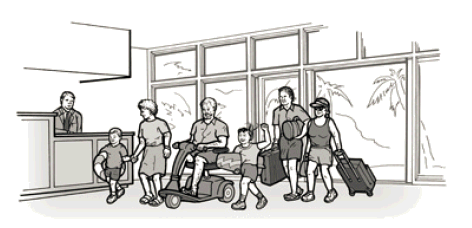Wheelchairs and Other Power-Driven Mobility Devices
People with mobility, circulatory, or respiratory disabilities use a variety of devices for mobility. Some use walkers, canes, crutches, or braces while others use manually-operated or power wheelchairs, all of which are primarily designed for use by people with disabilities. Businesses must allow people with disabilities to use these devices in all areas where customers are allowed to go.

Devices categorized as wheelchairs must be permitted.
Advances in technology have given rise to new power-driven devices that are not necessarily designed for people with disabilities, but are being used by some people with disabilities for mobility. The term “other power-driven mobility devices” is used in the revised ADA regulations to refer to any mobility device powered by batteries, fuel, or other engines, whether or not they are designed primarily for use by individuals with mobility disabilities for the purpose of locomotion. Such devices include Segways®, golf cars, and other devices designed to operate in non-pedestrian areas. Public accommodations must allow individuals who use these devices to enter their premises unless the business can demonstrate that the particular type of device cannot be accommodated because of legitimate safety requirements. Such safety requirements must be based on actual risks, not on speculation or stereotypes about a particular class of devices or how they will be operated by individuals using them.
Businesses must consider these factors in determining whether reasonable modifications can be made to admit other power-driven mobility devices to their premises:
- The type, size, weight, dimensions, and speed of the device;
- The business’s volume of pedestrian traffic (which may vary at different times of the day, week, month, or year);
- The business’s design and operational characteristics, such as its square footage, whether it is indoors or outdoors, its placement of stationery equipment or devices or furniture, and whether it has storage space for the device if requested by the customer;
- Whether legitimate safety standards can be established to permit the safe operation of the device; and
- Whether the use of the device creates a substantial risk of serious harm to the environment or natural or cultural resources or poses a conflict with Federal land management laws and regulations.
Using these assessment factors, a business may decide that it can allow devices like Segways® in its facilities, but cannot allow the use of golf cars in the same facility. It is likely that many businesses will allow the use of Segways® generally, although some may decide to exclude them during their busiest hours or on particular shopping days when pedestrian traffic is particularly dense. Businesses are encouraged to develop written policies specifying when other power-driven mobility devices will be permitted on their premises and to communicate those policies to the public.
Businesses may ask individuals using an other power-driven mobility device for a credible assurance that the device is required because of a disability. An assurance may include, but does not require, a valid State disability parking placard or other Federal or State-issued proof of disability. A verbal assurance from the individual with a disability that is not contradicted by your observation is also considered a credible assurance. It is not permissible to ask individuals about their disabilities.

User Comments/Questions
Add Comment/Question